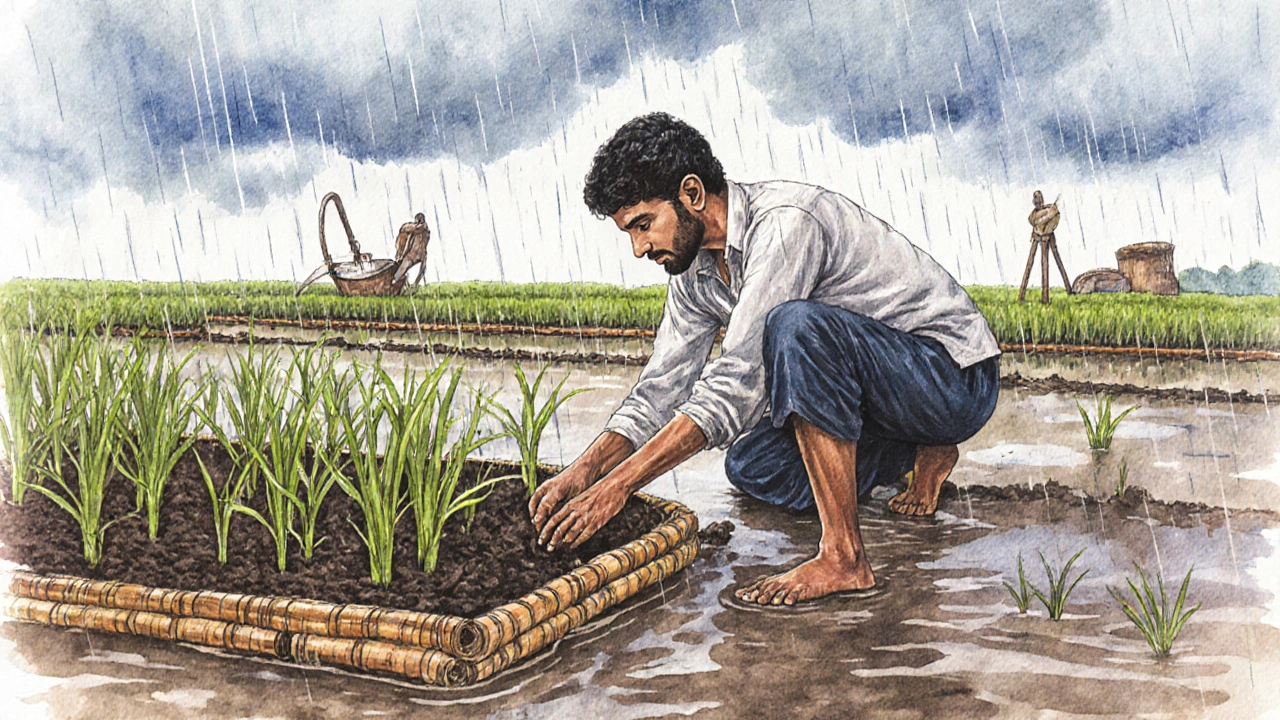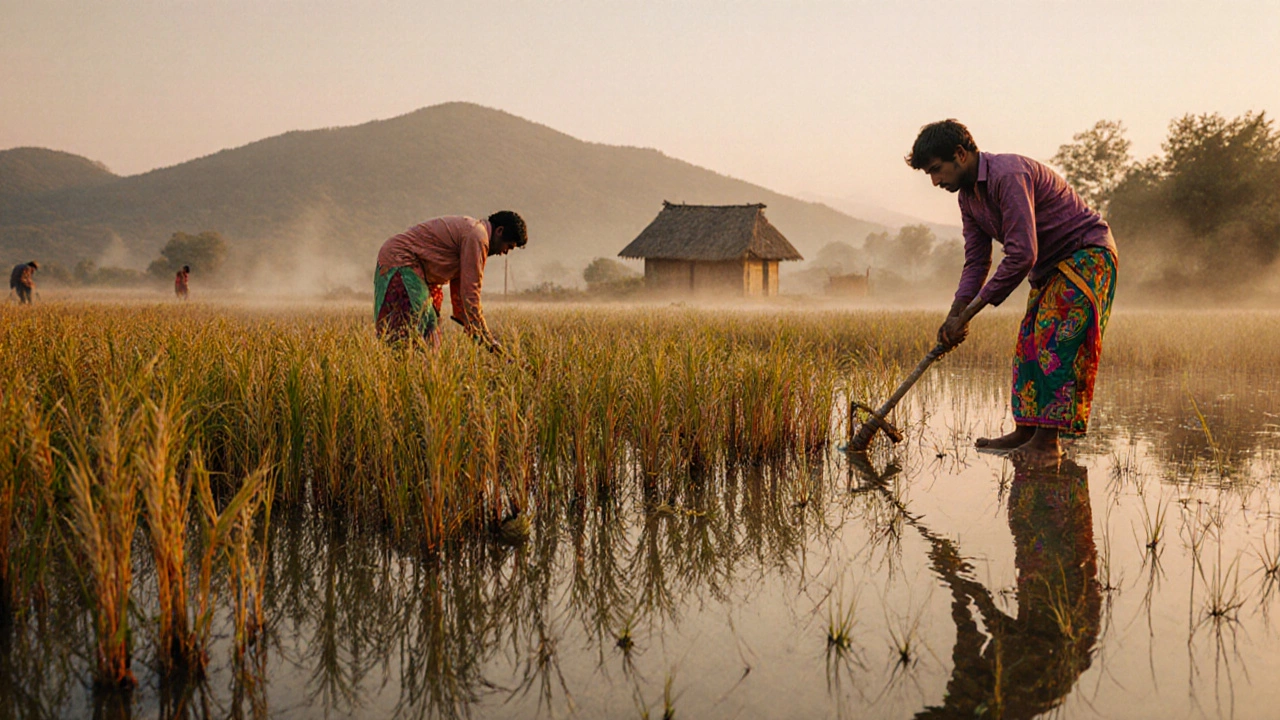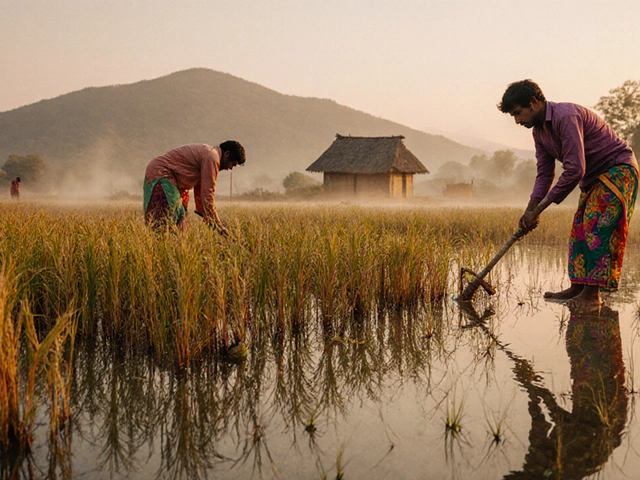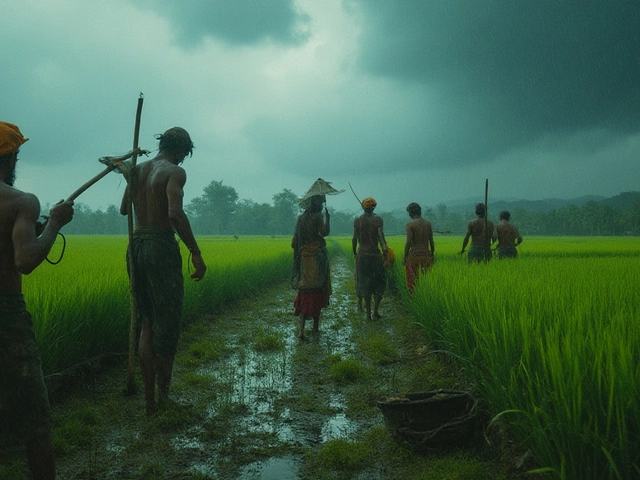If you’ve ever watched rice grow in a field, you might wonder: does it come back every year on its own? The short answer is no-rice doesn’t naturally regrow after harvest like some perennials do. But why? And how do farmers keep getting rice year after year? It’s not magic. It’s timing, soil, and a lot of work.
Rice Is an Annual Crop, Not a Perennial
Rice (Oryza sativa) is classified as an annual plant. That means it completes its entire life cycle-from seed to seed-in one growing season. After the grains are harvested, the plant dies. You won’t find rice stalks popping up again next spring unless someone replants them.
This is different from plants like asparagus or rhubarb, which send up new shoots year after year from the same root system. Rice doesn’t have that kind of resilience. Its roots are shallow, and once the panicles are cut, the plant has no energy left to regenerate. Even if you leave stubble in the field, it won’t sprout new growth. The plant’s biology is built for one big push: grow fast, make seed, die.
There are exceptions, though. Scientists have developed experimental perennial rice varieties-like Oryza longistaminata hybrids-that can regrow for two or three seasons. These are still in testing phases in places like China and parts of Africa. But for 99% of the world’s rice farmers, including those in Arkansas, California, or the Mekong Delta, rice is planted fresh every year.
How Do Farmers Keep Growing Rice Year After Year?
If rice doesn’t come back, how do we have rice on our plates every season? The answer is replanting-and it’s not as simple as tossing seeds into the ground.
Most rice is grown in flooded fields called paddies. Before planting, farmers prepare the soil by plowing, leveling, and flooding it. Then they either broadcast seeds by hand or transplant young seedlings grown in nurseries. Transplanting is more common in Asia, where labor is abundant and precision matters. In the U.S. and Australia, direct seeding with machinery is the norm.
The timing is critical. Rice needs warm temperatures-usually above 20°C (68°F)-and a long growing season of 120 to 180 days, depending on the variety. In temperate zones like northern Italy or the U.S. Midwest, planting happens in late spring. In tropical regions like Bangladesh or Thailand, farmers can grow two or even three crops a year because the weather stays warm year-round.
After harvest, the field is drained, and the leftover straw is often burned or tilled back into the soil. Some farmers use cover crops like clover to rebuild nitrogen levels. Others rotate rice with soybeans or vegetables to prevent soil exhaustion. Without these practices, the soil would lose nutrients fast, and yields would drop.
Why Can’t Rice Be a Perennial Like Grass?
It’s a fair question. Grasses like wheat, barley, and even wild rice can sometimes behave like perennials. Why not cultivated rice?
The answer lies in selective breeding. Over thousands of years, humans bred rice to produce large, heavy grain heads. That’s great for feeding people-but it comes at a cost. The plant puts all its energy into making seeds, not into building strong roots or underground stems (rhizomes) that could survive winter or drought.
Wild rice species, like Oryza rufipogon, do have perennial traits. They grow in wetlands and regrow from rhizomes. But they produce tiny grains, and their harvest is unpredictable. Farmers didn’t select for those traits. They wanted yield, not resilience.
Modern science is trying to fix that. Researchers at the International Rice Research Institute (IRRI) have spent decades crossbreeding wild perennial rice with high-yield strains. The result? Varieties like Perennial Rice 23 can regrow for up to four seasons without replanting. They’ve been tested in Yunnan, China, where farmers report saving 30-50% on labor and seed costs. But these varieties aren’t widely available yet. Most rice fields still rely on annual planting.

What Happens to Rice Fields Between Seasons?
After harvest, rice fields don’t just sit idle. They go through a cycle of rest, renewal, and preparation.
- Drainage: Water is removed so the soil can dry out. This helps control pests and diseases that thrive in wet conditions.
- Residue management: Stubble is either burned (common in India and Southeast Asia, though increasingly banned due to air pollution) or chopped and mixed into the soil to add organic matter.
- Soil testing: Farmers check pH and nutrient levels. Rice prefers slightly acidic soil (pH 5.5-6.5). If it’s too alkaline, they add sulfur. If nitrogen is low, they apply fertilizer or plant legumes.
- Land leveling: Fields are graded so water flows evenly during the next planting. Uneven land means some areas drown while others dry out.
- Water system maintenance: Ditches, canals, and pumps are cleaned so water can be delivered efficiently next season.
This post-harvest work is just as important as planting. Skip it, and next year’s crop suffers. Poor drainage leads to root rot. Compacted soil slows growth. Nutrient-depleted fields produce thin, weak plants.
Can You Grow Rice at Home Like a Houseplant?
Some people try growing rice in pots or small containers, thinking it’s like growing herbs. It’s possible-but it’s not easy, and it won’t come back next year.
To grow rice at home, you need:
- A container at least 6 inches deep and 18 inches wide
- Soil that holds water well (like clay-loam mix)
- At least 4-6 hours of direct sunlight daily
- Water kept 2-4 inches deep during the growing season
- Seeds from a reputable supplier (not from your last bowl of rice-those are usually polished and won’t sprout)
Even under perfect conditions, you’ll get maybe a cup of grain from one plant. And after harvest? The plant dies. You’ll need to buy new seeds and start over next spring. There’s no way around it.
Some gardeners grow ornamental rice varieties for their tall, swaying stalks and purple grains. These are fun to watch but still annuals. They don’t survive winter, even indoors.

What About Wild Rice? Does That Come Back?
Wild rice (Zizania palustris) isn’t true rice. It’s a different genus, native to North American lakes and rivers. But it’s often called rice because of its appearance and use.
Wild rice does behave more like a perennial. It grows from rhizomes under water and can return year after year if left undisturbed. Native American tribes like the Ojibwe have harvested wild rice sustainably for centuries, letting the plants reseed naturally.
But commercial wild rice is mostly farmed now-and even then, it’s usually direct-seeded each year. The wild stands are fragile. Pollution, water level changes, and overharvesting have reduced natural beds. So even though wild rice has perennial potential, most of what ends up in your pantry is still replanted annually.
Why Does This Matter for Sustainable Farming?
Rice farming uses about 30% of the world’s freshwater. It’s also a major source of methane emissions-more than all commercial airplanes combined. Every time farmers drain and flood fields, microbes in the soil release methane as they break down organic matter.
Perennial rice could change that. Fewer plantings mean less fuel for tractors, less water pumped, fewer emissions from soil disturbance. If perennial varieties become mainstream, they could cut rice farming’s carbon footprint by up to 40%.
That’s why scientists are pushing hard. The goal isn’t just to make rice come back-it’s to make it better. More efficient. Less harmful. More resilient to climate change.
For now, though, if you want rice next year, you’ve got to plant it again. No shortcuts. No free lunches. Just hard work, smart soil care, and respect for the crop’s biology.
What’s the Future of Rice Farming?
Perennial rice is still experimental. But it’s not science fiction. China has already released the first commercial variety. Farmers there report yields close to traditional rice-with half the labor.
In the next decade, we may see more varieties approved in Southeast Asia, Africa, and even parts of the U.S. The big challenge? Making sure these new strains can handle pests, floods, and heat stress without losing yield.
For home gardeners? Stick with annuals. For global food systems? Perennial rice might be one of the quietest revolutions in agriculture.
Does rice grow back after you cut it?
No, rice doesn’t regrow after harvest. Once the grains are removed, the plant dies. It’s an annual crop, meaning it completes its life cycle in one season. Leaving the stalks won’t result in new growth. You must replant seeds or seedlings each year.
Can you grow rice from store-bought rice?
Usually not. Most rice sold in stores is polished or parboiled, which removes the germ needed for sprouting. Even brown rice may have been treated or stored in conditions that kill viability. To grow rice, you need untreated, whole grain seeds from a garden supplier or agricultural cooperative.
How many times a year can you harvest rice?
In tropical regions with warm winters, farmers can grow two or even three rice crops per year. In temperate zones like the U.S. or Europe, only one crop is possible due to frost. The number of harvests depends on temperature, water availability, and variety.
Is wild rice a perennial?
Yes, wild rice (Zizania species) is naturally perennial. It grows from underground rhizomes and can return year after year in natural wetlands. However, most wild rice sold today is farmed using annual seeding methods to ensure consistent yields.
Why don’t farmers just let rice reseed itself?
Rice plants drop seeds, but they don’t germinate reliably in the same field. The soil gets compacted, water levels change, and weeds take over. Plus, modern rice varieties have been bred for high yield, not self-sowing. Farmers control planting to ensure uniform growth, pest control, and harvest timing.



